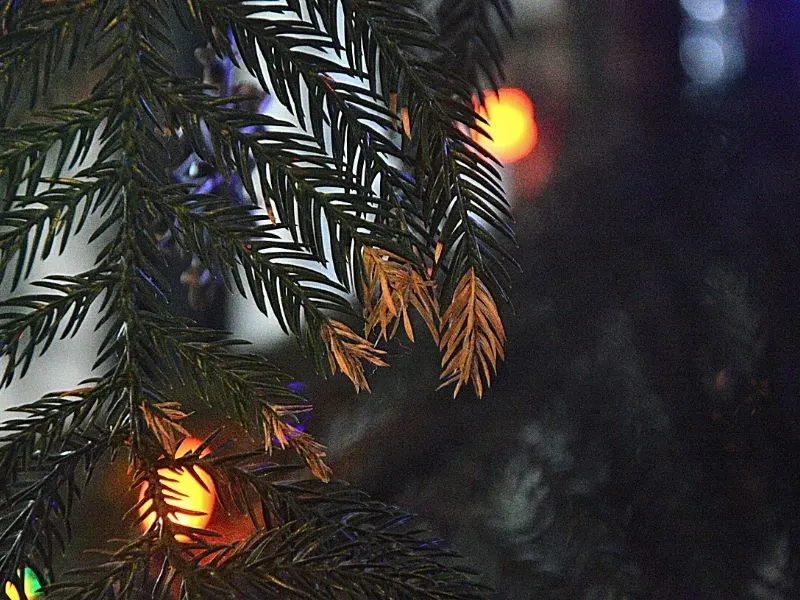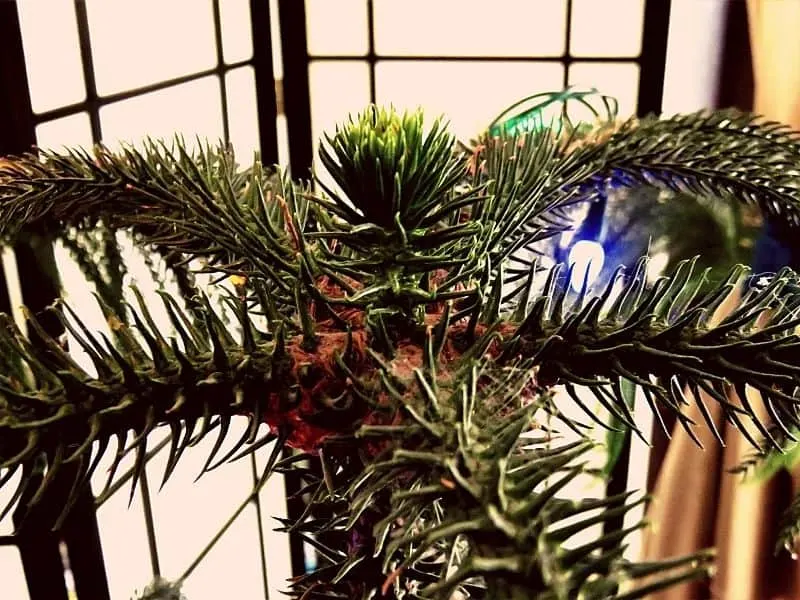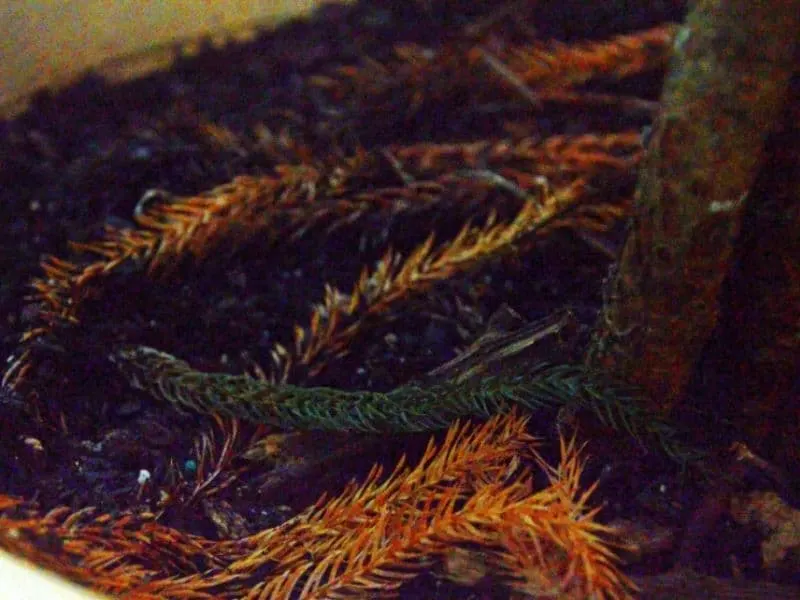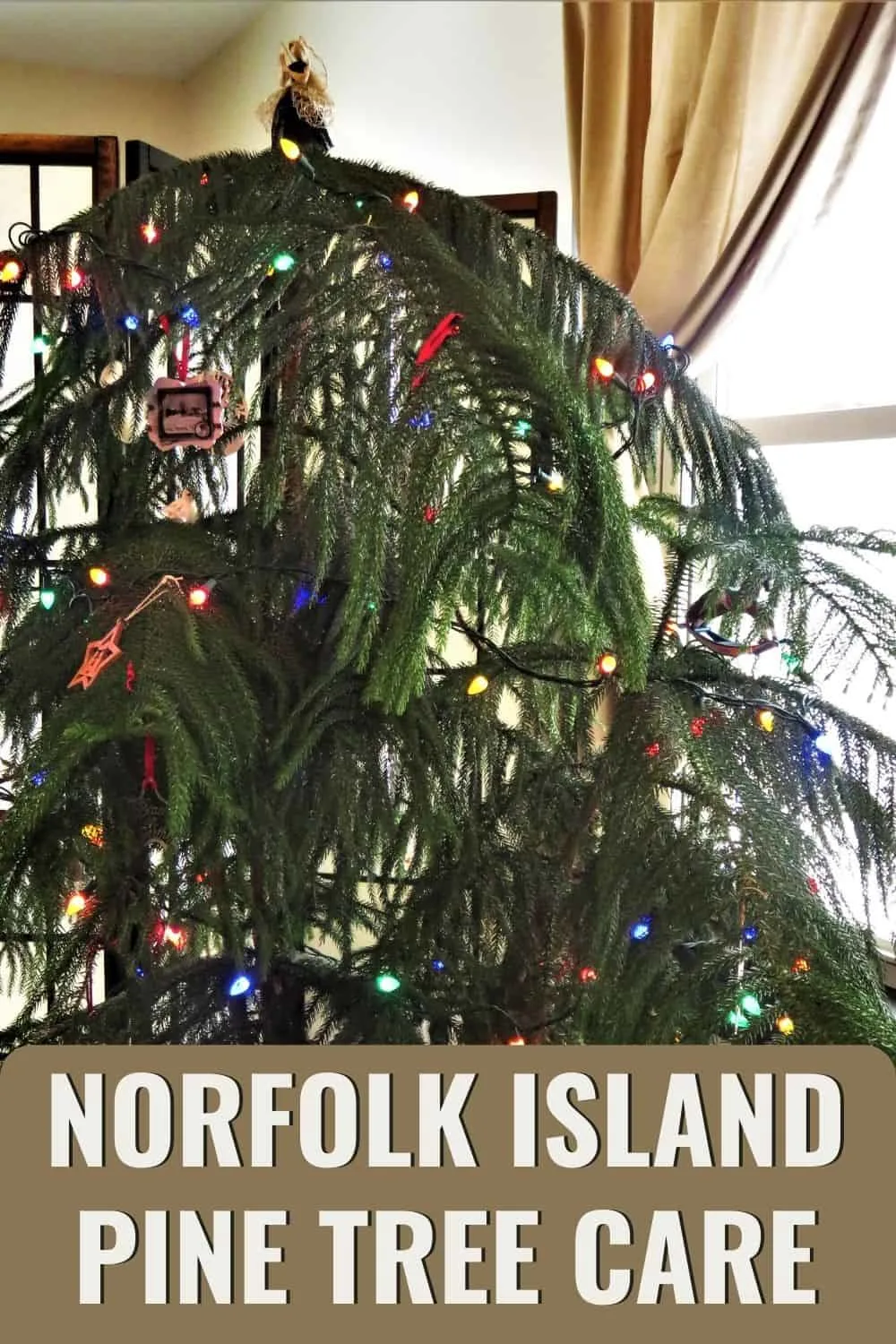While most people pull their Christmas tree out of a box or purchase a cut tree from a farm, for the past couple of years we’ve simply moved ours from the dining room to the living room for the holiday season. It may not have quite the same charm as a cut tree, but it’s significantly better for the environment and serves as a lovely houseplant the rest of the year. I’m talking about a Norfolk Island pine (Araucaria heterophylla), often shortened to Norfolk pine.

As their name indicates, these trees come from Norfolk Island, an Australian territory in the South Pacific. They are not, however, true pines but rather members of the prehistoric Araucariaceae family of conifers, which went extinct in the northern hemisphere around the same time dinosaurs did. In their native habitat, Norfolk Island pines can grow up to 200 feet tall with trunks 10 feet in diameter.
That’s hard to believe when the trunks of my “mature” Norfolk Island pine are hardly wider than my thumb! But when kept as a houseplant, this tree will grow slowly, reaching only about five to eight feet tall in ten years. This makes it the perfect size for decorating as a Christmas tree or cheering up a bright corner.
Norfolk Island Pine Tree Care
Being tropical plants, Norfolk Island pines like bright sunlight and high humidity. Place your tree in front of a south-facing window if possible, or at least in a location that receives bright indirect light. Turning it every week or so will keep it growing full and straight.
Although Norfolk Island pines tolerate average household humidity levels, they will do best with more humid conditions. To provide this, surround your tree with other houseplants or place a saucer of pebbles and water under the tree, ensuring that the plant does not sit directly in the water. A weekly misting will also do the trick. Additionally, avoid putting the tree in a place where it might feel drafts from doors, windows, and air vents.
As with most houseplants, water your Norfolk Island pine as soon as the top inch of soil feels dry. Fertilizing isn’t imperative, but you can feed the tree once a year or as often as every two weeks, if you want it to grow faster, with a general-purpose houseplant fertilizer. Regardless, do not feed it during the winter-spring seasons: summer is best.
Norfolk Island pine pruning

Should you prune your Norfolk Island pine? No. Cutting it back will make the tree look distorted or even encourage it to become shrubby. As the tree matures, a few lower branches will naturally die, and these can be removed — they’ll usually fall off of their own accord, but you can also snip them off with pruners. If, however, it begins dropping numerous branches, make sure that it is receiving proper care (see the FAQs below for more details).
But what if the tree gets too tall for the space it’s in? Trimming the top off of a Norfolk Island pine will likely not harm it, so if it threatens to touch the ceiling, you can cut off the very top of the tree, removing just the “star cluster” of new growth or as much as desired down to just above a whorl of branches. This will prevent it from growing any taller, but it won’t be as pretty.
Repotting a Norfolk Island pine
Norfolk Island pine trees only need to be repotted about once every two to three years.
Keep in mind that putting it in a larger pot will encourage the tree to grow bigger, so if you want to slow its growth, repot into a similar-sized container with fresh soil. For best results, choose a well-draining potting soil, ideally one containing sand and coconut coir, and a container with drainage holes.
Norfolk Island pine propagation – seeds vs. cuttings
While you can propagate a Norfolk Island pine from cuttings, it’s difficult to do. Instead, many experts recommend propagating these trees from seed. First, obtain the freshest Norfolk Island pine seeds possible, as they can lose their viability within a matter of months.
Fill small pots with sterile potting soil or soilless growing medium and place the seeds on the surface of the soil. Planting multiple seeds in the same pot will result in a fuller appearance: my “tree” is actually made up of four trunks.
Place the pots in a bright window and keep them at 70 to 80 F, using a heat mat if necessary. Use a plant mister to keep the soil moist but never soggy. In 10 to 21 days, you should begin to see sprouts appear! At this point, average household temperatures should suffice (60 to 90 F), and you can begin watering normally once the young saplings are established.
If you have decided to trim the top off anyway (see the “pruning” section above), you can try rooting the cutting. It has to be the growing top, as a branch will not grow into a tree but rather continue growing as a branch, though it will root. Remove the needles from the bottom inch of the cutting, then insert the cutting into a clean, well-draining growing medium. If desired, you can apply a rooting hormone (this is the one I use) to improve your chances of success before planting the cutting.
Cover the pot with a clear plastic bag to form a humidity tent, or place it in a terrarium or greenhouse. Check on it daily and moisten the soil as needed. Because Norfolk pines grow slowly, this process takes some patience, but if all goes well, you should eventually see signs of new growth.
Common Norfolk Island pine problems and FAQs
Why are the needles on my Norfolk Island pine turning brown or yellow?
Brown or yellow needles often indicate insufficient humidity, so try surrounding the tree with other houseplants, placing a tray of pebbles and water underneath, misting the branches weekly, or putting a dehumidifier in the room.
If humidity doesn’t seem to be the problem, look for other potential stressors, such as too direct or too little sunlight, over- or underwatering, or a draft. See the “Care” section above for ideal conditions.
Why are the branches of my Norfolk Island pine falling off?

Norfolk Island pines may drop a few lower branches as they grow, but if the branch dropping seems excessive, it may be a sign of stress. Make sure that the tree receives proper levels of humidity and soil moisture. Water thoroughly as soon as the top inch of soil feels dry, but never let the plant sit in water or become soggy.
Is Norfolk Island pine toxic to cats or other pets?
Ingesting the needles of a Norfolk Island pine can cause severe stomach irritation for both humans and pets, so it’s best to keep it out of reach of curious nibblers.
Can I plant my Norfolk Island pine outside?
That depends. Where do you live? Norfolk Island pine trees don’t tolerate freezing temperatures, so if your winters dip below 35 F, keep it inside. In the U.S., Orlando marks the northern range for growing Norfolk pines outdoors. In USDA hardiness zones 9 and below, you can place the potted tree outside during the summer. In fact, they will thrive in warm, humid summer conditions as long as they aren’t thrust out into direct afternoon sunlight: this will cause sunburn.
How lovely are thy branches …
Norfolk Island pine trees can be a bit finicky about moisture, but as long as you provide sufficient humidity and soil moisture, they will reward you with beautiful, lush branches. Decorate them with lightweight ornaments for Christmas, or simply enjoy their cheery, comforting presence year-round.
Want more Christmas plants? You’ll love a poinsettia or two around the living room, and a Christmas cactus is a great addition to your houseplant collection.

Serena Manickam is a freelance editor and writer and sustainable market gardener in rural Virginia. She holds a BA in environmental science and runs Fairydiddle Farm, a small market garden in which she grows no-spray produce and herbs to sell at a local farmer’s market.


20 Creative Gardening Gifts For Women That Will Make An Impression
Friday 14th of April 2023
[…] also great for Mother’s Day, Christmas, and birthday gifts. Indoor plants like poinsettias, Norfolk Island pines, orchids, and tropical plant varieties are great for winter gift-giving. They add color to a […]
The 11 Best Large Indoor Plants For Your Home
Monday 6th of February 2023
[…] Here’s how to care for your Norfolk Island tree. […]
Beautiful Flower Garden Ideas
Wednesday 10th of March 2021
[…] Norfolk Island Pine – Care Tips for the Christmas Tree Houseplant […]